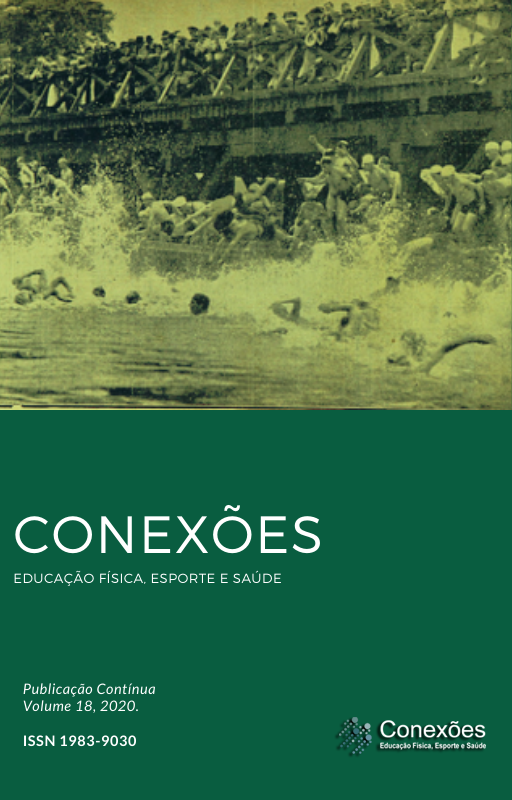Abstract
Objective: The aim is to analyze how the contemporary circus company Cirque du Soleil progressively increases the dramatic intensity of the scenes ine. its creations in order to transfer its form of composition to other creations, and also to propose the criteria used, in a pedagogical context that uses circus as an educational resource. The methodology used is observational, through the application of a field format, applied to the study of the ten shows of the company premiered between 1986 and 2005. This instrument was made by applying the lenses of the motor action science, the motor praxiology. Results and discussion: The results show various forms of accentuation of dramatic intensity, linked to the components of the internal logic of the circus show: to colleagues, increasing the number of people involved in carrying out motor actions; to the space, varying the figures, increasing their difficulty and risk, increasing the height in which they are made, or reducing the support surface; at the time, prolonging the flight times, maintaining the execution time of various figures, or increasing the execution speed; and to objects, increasing the number of objects involved in the numbers. The conclusions indicate that the exhaustive knowledge of the components of the internal logic of the circus will allow to recreate crescendos in the dramaturgy of the circus numbers. As final considerations indicate that these forms of crescendo are used in the progression of the numbers of a professional company, but they are equally applicable to the composition of circus scenes in an educational context.
References
ANGUERA, Maria Teresa; BLANCO, Angel; LOSADA, José Luis; HERNÁNDEZ MENDO, Antonio. La metodología observacional en el deporte: conceptos básicos. Lecturas: EF y Deportes. Revista Digital, 24, agosto 2000. Disponible en: http://www.efdeportes.com/efd24b/obs.htm.
BARRAULT, Denys; GOUDARD, Philippe. (Coords.). Médecine du cirque. Vic la Gardiole: Coédition éditions L’Entretemps et le Centre Nacional des Arts du Cirque. 2004.
COLLARD, Luc. Sports, enjeux et accidents. Tesis Doctoral. París: Sorbonne París V, 1997.
CIRQUE DU SOLEIL. La magie continue (1986). Cirque du Soleil Images (Formerly Known as Productions Télémagic Inc.), Columbia Tristar Home Entertainment. 2004. 1 DVD (49”).
CIRQUE DU SOLEIL. Dralion (2000). Cirque du Soleil Images (Formerly Known as Productions Télémagic Inc.), Columbia Tristar Home Entertainment. 2000. 1 DVD (89”).
CIRQUE DU SOLEIL. Varekai (2002). Cirque du Soleil Images (Formerly Known as Productions Télémagic Inc.), Columbia Tristar Home Entertainment. 2003. 1 DVD (90”).
CIRQUE DU SOLEIL. La Nouba (1998). Cirque du Soleil Images (Formerly Known as Productions Télémagic Inc.), Columbia Tristar Home Entertainment. 1998. 1 DVD.
CIRQUE DU SOLEIL. Corteo (2005). Cirque du Soleil Images (Formerly Known as Productions Télémagic Inc.), Columbia Tristar Home Entertainment. 2005. 1 DVD.
DAVID, Gwénola. Les accidents du récit: une poétique de l’espace-temps. En: WALLON, Emmanuel. (dir. et la collaboration de C. Hodak-Druel) Le cirque au risque de l’art. Arles: Actes Sud-Papiers, Claire David, 2002. p. 123-131.
EWERT, A.; HOLLENHORST, S. Testing de adventure model: empirical support for a model of risk recreation participation. Journal of leisure research v. 21, n. 2, p. 124-139, 1989.
JACOB, Pascal. Présentation au milieu professionnel de la politique du Ministère de la Culture en faveur des arts de la piste, en Arts de la piste, 5, Premier trimestre, v. 45, 1997.
LAGARDERA, Francisco; LAVEGA, Pere. Introducción a la praxiología motriz. Barcelona: Paidotribo, 2003.
LAGARDERA, Francisco; LAVEGA, Pere. (Eds.). La ciencia de la acción motriz. Lleida: Edicions de la Universitat de Lleida, 2004.
MALLET, Rodrigo; BORTOLETO, Marco Antonio Coelho. Educaçao física escolar. Pedagogia e didática das atividades circenses. Rev. Br. Cien. Esporte. Campinas, v. 28, n. 2, p. 171-189, 2007.
MARTIN, Peter; PRIEST, Simon. Understanding the adventure experience. Journal of Adventure Education, v. 3, p. 18-21, 1986.
MARTÍNEZ VIDAL, Aurora. La dimensión artística de la Gimnasia Rítmica. Tesis Doctoral no publicada. Universidad de Vigo, Facultad de Bellas Artes, 1997.
MARTÍNEZ VIDAL, Aurora. Aproximació a l'esport a través dels principis artístics: creativitat, expressió i estètica. Apunts d’educació física i esports, v. 58, p. 88-92, 1999.
MATEU, Mercè. Observación y análisis de la expresión motriz escénica. Estudio de la lógica interna de los espectáculos artísticos profesionales: Cirque du Soleil (1986‐2005). Tesis doctoral. Universitat de Barcelona, 2010.
MATEU, Mercè; BORTOLETO, Marco Antonio Coelho. Las situaciones motrices de expresión y los dominios de acción. Actas del IX Seminario Internacional de Praxiología Motriz, Las Palmas de Gran Canaria, 2005.
MATEU, Mercè; BORTOLETO, Marco Antonio Coelho. La lógica interna y los dominios de acción motriz de las situaciones motrices de expresión (SME). Emancipação, Ponta Grossa, v. 11, n. 1, p. 129-142, 2001. Disponível em: http://www.revistas2.uepg.br/index.php/emancipacao.
ONTAÑÓN, Teresa; BORTOLETO, Marco Antonio Coelho. Todos a la pista: el circo en las clases de edicación física. Apunts. Educación Física y Deportes, v. 115, 1.er trimestre (enero-marzo), p. 37-45, 2014.
MICHEL, Guy. La prise de risque à l’adolescence: pratique sportive et usage de substances psycho-actives. Paris: Masson, 2001.
PARLEBAS, Pierre. (1988). Elementos de sociología del deporte. Málaga: Junta de Andalucía. Col. Unisport. Reedición: IAD, 2003.
PARLEBAS, Pierre. Juegos, deporte y sociedad. Léxico de praxiología motriz. Traducido por González del Campo Román, adaptado y revisado por Lagardera, F.; Lavega, P. Barcelona: Paidotribo, 2001. Título original: Jeux, sports et société. Léxique praxeologie motrice.
SHRIER, Ian; MEEUWISSE, Willem H.; MATHESON, Gordon O.; WINGFIELD, Kristin; STEELE, Russell J.; PRINCE, François; HANLEY, James; MONTANARO, Michael. Injury patterns and injury rates in the circusarts: an analysis of 5 years of data from Cirque du Soleil. J Sports Med, v. 37, p. 1143-1149, originally published online March 13, 2009. Disponible en: http://ajs.sagepub.com/content/37/6/1143.
WALLON, Emmanuel (Ed.). Le cirque au risque de l’art. Arles: Actes Sud-Papiers, Apprendre, 2002.
ZUCKERMAN, Marvin. Behavioral Expressions and Biosocial Bases of Sensation Seeking. New York: Cambridge University Press, 1994.
The Conexões: Educação Física, Esporte e Saúde Journal uses the license of Creative Commons (CC), thus preserving the integrity of articles in an open access environment.


